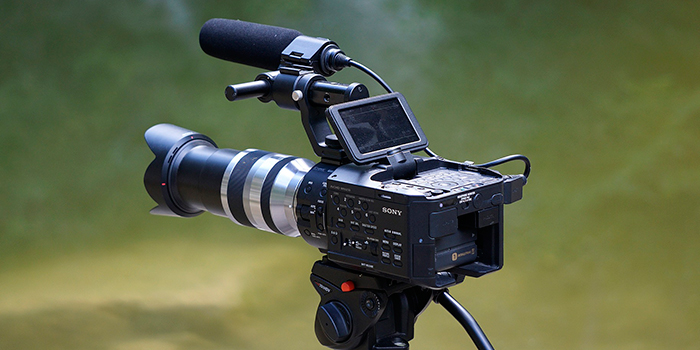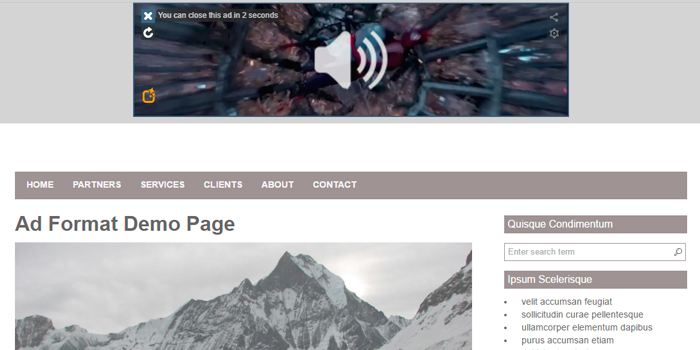True or false?
Original digital video content:
- Will soon be as important as original TV programming
- Reaches audiences that TV can’t
- Is more engaging than TV
According to two-thirds of video advertisers surveyed by the IAB, the answer is “True to all of the above.”
It’s not just talk. Advertisers are betting big money that formats like in-stream video ads will deliver even bigger returns in the next few years.
And it turns out, they may be onto something.
Video is the future
The IAB survey revealed that average video ad spend almost doubled between 2014 and 2016. A report by eMarketer indicates the US digital video advertising market is projected to almost double again by 2019.
Video ads – whether out-stream or in-stream – are making a big push to capture (and keep) user attention. They’re slightly less resource intensive than an interactive experience like a 360 ad or game ad, but done right, they can be just as memorable.
The case for in-stream video ads
While users don’t initiate video content to view an ad, pre-roll ads have become a widespread and accepted fixture of video content in the digital display landscape.
Audience-based buying and targeting tools make it easy to deliver relevant, user-initiated ads to the right audience. That’s makes in-stream video ads great for boosting brand awareness.
And since in-stream video ads are tied to publisher content, that provides an opportunity for advertisers to create complementary campaigns, boosting user engagement.
A faster horse
Henry Ford famously said (or didn’t) “If I had asked people what they wanted, they would have said faster horses.” While the quote’s origin may be in question, the sentiment behind it is sound:
People are irrational. Especially when it comes to their feelings around ads.
In-stream video ads have been around for several years. While some consumers still grumble about them, they’re an accepted part of the online experience.
More importantly, when consumers complain about in-stream video ads (or any ad), they’re really complaining about bad ads. Irrelevant, disruptive and poorly executed ads. Consumers reward advertisers that create useful or entertaining ads.
Don’t believe us?
Rewards for good in-stream video ads
Consider the reception of two recent famous – or infamous – ad campaigns, both centered around… pooping.
- While unicorns – and ice cream- may be ruined forever, this Squatty Potty ad has clocked over 50 million views on Facebook and YouTube. The company also saw a 600 percent increase in online sales.
- The original PooPourri ‘Girls Don’t Poop’ video redefined the pre-roll ad and is nearing 39 million views. The company racked up $4 million in backorders and almost buckled under the demand.
Brands with good in-stream video ads are rewarded with views, shares and increased brand awareness.
Lack of inventory (and why that’s a good thing)
Critics of in-stream video ads frequently cite the lack of inventory. Advertisers have video ads, but their in-stream options are limited. Many platforms don’t offer them and competition is tight for the platforms that do.
They’re all valid points (and we’ll discuss the benefits of outstream video ads in a future post). But, as advertisers have been shifting to the more readily available outstream video ads, that removes competition from the in-stream video ad marketplace.
The demand is also good incentive for platforms and publishers – who can deliver higher CMP for in-stream video ads due to their placement in user-initiated content – to look for ways to expand their inventory, benefitting their users with more quality content in the process.
Flexibility and more options
For agencies, offering in-stream video ad services makes it possible to better serve clients (and stand out from the competition). The more video formats you can deliver, the more robust – and effective – campaigns you can deliver. Don’t have the in-house production capabilities? Use our screening questions to find a quality digital production agency.
If you’re an AdTech platform or publisher, expanding your in-stream video ad advertising space means you have more to offer potential advertisers (which increases your chance of winning their budget).
Just avoid the unforgivable
Remember: if you violate any of the advertising best practices, it doesn’t matter how compelling your in-stream video ads are. Viewers will punish you with brand awareness. Negative brand awareness. So keep these tips in mind.
- What got you there may not get you here. In-stream video ads can make for a great cross-screen experience. Just be sure to design experiences based on the destination screen. And don’t forget desktop. Advertisers have been quick to jump on mobile, sometimes at the expense of desktop opportunities.
- Keep it short and sweet. In-stream video ads, while powerful, are still acting as a barrier to or interruption of content that your target audience wants to consume. Respect their time and keep your ads short and interesting.
- This ain’t TV. TV, mobile and desktop are different devices, used for different purposes. So why are you still repackaging TV ads into in-stream video ads? Stop. Partner with a good digital production agency and tailor your content to the audience, platform and device you’re targeting.
- Go where the fish are. Make sure you’re getting the most from your in-stream video ad investment . Use audience-based buying and platforms with advanced metrics and targeting capabilities to track and target your campaigns better.
- Audit the process. Whether you’re an advertiser, platform or publisher, make sure your in-stream video ads are displaying appropriately. Serving the same Personalized video ads multiple times during a content series, autoplaying without permission, forcing long ads ahead of short-form content – those are all no-no’s.
Over to you! Are you using in-stream video ads in your marketing efforts? If so, have you noticed a boost in engagement, sales or other key performance metrics?









One Reply to this post
Great stuff. But marketers can also try moLotus rich media mobile video messaging platform. It is an innovative medium that is better than all other traditional channels. This revolutionary platform helps businesses acquire more customers, automate their marketing processes while maximizing profit.